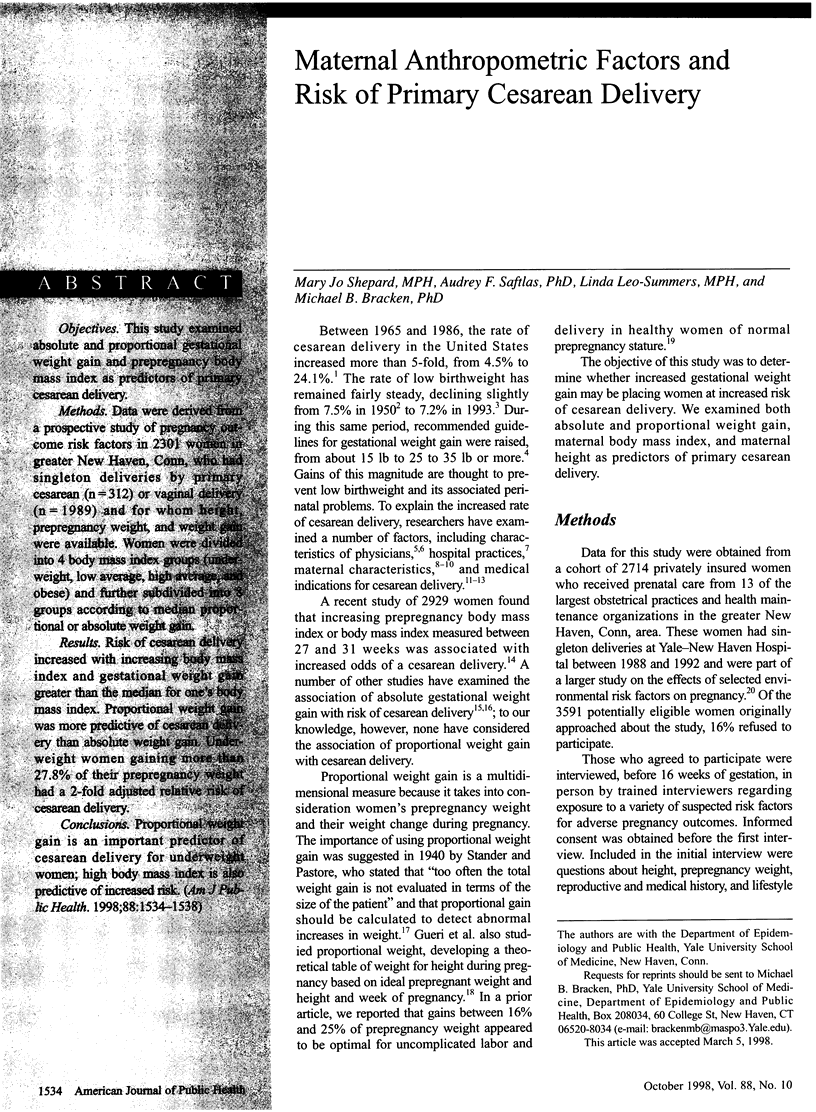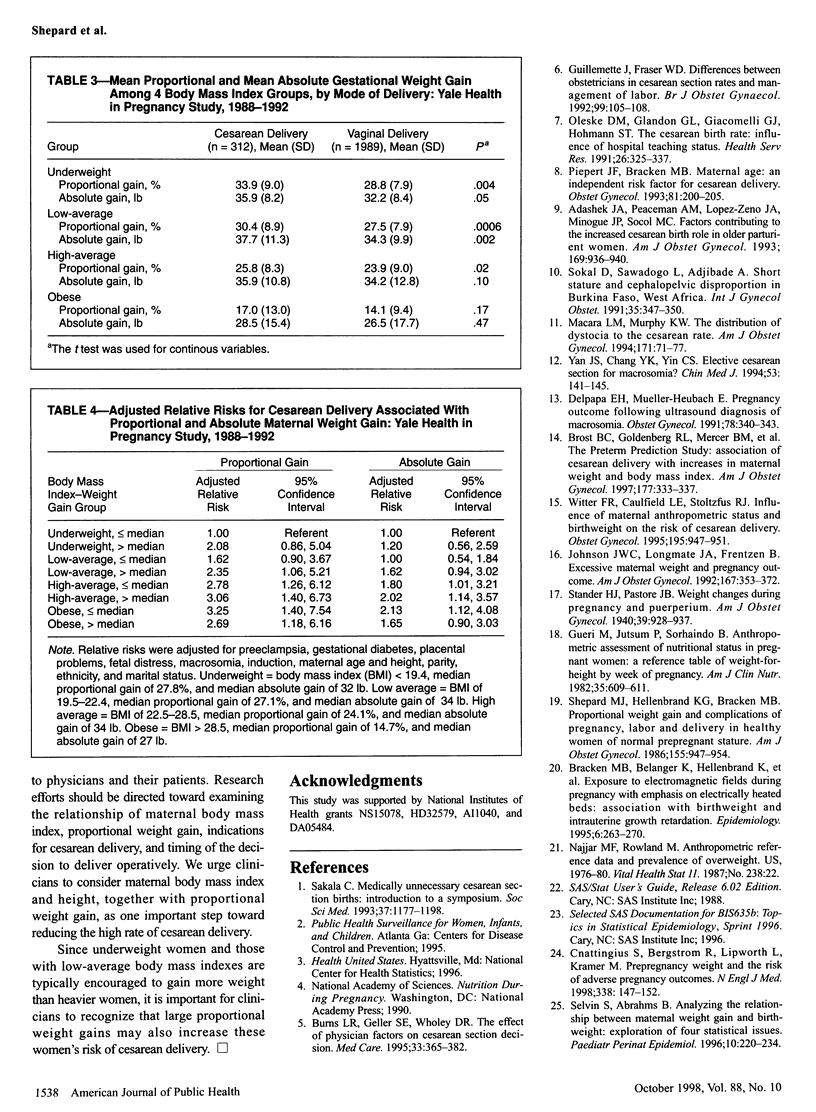Abstract
OBJECTIVES: This study examined absolute and proportional gestational weight gain and prepregnancy body mass index as predictors of primary cesarean delivery. METHODS: Data were derived from a prospective study of pregnancy outcome risk factors in 2301 women in greater New Haven, Conn, who had singleton deliveries by primary cesarean (n = 312) or vaginal delivery (n = 1989) and for whom height, prepregnancy weight, and weight gain were available. Women were divided into 4 body mass index groups (underweight, low average, high average, and obese) and further subdivided into 8 groups according to median proportional or absolute weight gain. RESULTS: Risk of cesarean delivery increased with increasing body mass index and gestational weight gain greater than the median for one's body mass index. Proportional weight gain was more predictive of cesarean delivery than absolute weight gain. Underweight women gaining more than 27.8% of their prepregnancy weight had a 2-fold adjusted relative risk of cesarean delivery. CONCLUSIONS: Proportional weight gain is an important predictor of cesarean delivery for underweight women; high body mass index is also predictive of increased risk.
Full text
PDF




Selected References
These references are in PubMed. This may not be the complete list of references from this article.
- Adashek J. A., Peaceman A. M., Lopez-Zeno J. A., Minogue J. P., Socol M. L. Factors contributing to the increased cesarean birth rate in older parturient women. Am J Obstet Gynecol. 1993 Oct;169(4):936–940. doi: 10.1016/0002-9378(93)90030-m. [DOI] [PubMed] [Google Scholar]
- Bracken M. B., Belanger K., Hellenbrand K., Dlugosz L., Holford T. R., McSharry J. E., Addesso K., Leaderer B. Exposure to electromagnetic fields during pregnancy with emphasis on electrically heated beds: association with birthweight and intrauterine growth retardation. Epidemiology. 1995 May;6(3):263–270. doi: 10.1097/00001648-199505000-00013. [DOI] [PubMed] [Google Scholar]
- Brost B. C., Goldenberg R. L., Mercer B. M., Iams J. D., Meis P. J., Moawad A. H., Newman R. B., Miodovnik M., Caritis S. N., Thurnau G. R. The Preterm Prediction Study: association of cesarean delivery with increases in maternal weight and body mass index. Am J Obstet Gynecol. 1997 Aug;177(2):333–341. doi: 10.1016/s0002-9378(97)70195-9. [DOI] [PubMed] [Google Scholar]
- Burns L. R., Geller S. E., Wholey D. R. The effect of physician factors on the cesarean section decision. Med Care. 1995 Apr;33(4):365–382. doi: 10.1097/00005650-199504000-00004. [DOI] [PubMed] [Google Scholar]
- Cnattingius S., Bergström R., Lipworth L., Kramer M. S. Prepregnancy weight and the risk of adverse pregnancy outcomes. N Engl J Med. 1998 Jan 15;338(3):147–152. doi: 10.1056/NEJM199801153380302. [DOI] [PubMed] [Google Scholar]
- Delpapa E. H., Mueller-Heubach E. Pregnancy outcome following ultrasound diagnosis of macrosomia. Obstet Gynecol. 1991 Sep;78(3 Pt 1):340–343. [PubMed] [Google Scholar]
- Gueri M., Jutsum P., Sorhaindo B. Anthropometric assessment of nutritional status in pregnant women: a reference table of weight-for-height by week of pregnancy. Am J Clin Nutr. 1982 Mar;35(3):609–616. doi: 10.1093/ajcn/35.3.609. [DOI] [PubMed] [Google Scholar]
- Guillemette J., Fraser W. D. Differences between obstetricians in caesarean section rates and the management of labour. Br J Obstet Gynaecol. 1992 Feb;99(2):105–108. doi: 10.1111/j.1471-0528.1992.tb14464.x. [DOI] [PubMed] [Google Scholar]
- Johnson J. W., Longmate J. A., Frentzen B. Excessive maternal weight and pregnancy outcome. Am J Obstet Gynecol. 1992 Aug;167(2):353–372. doi: 10.1016/s0002-9378(11)91414-8. [DOI] [PubMed] [Google Scholar]
- Macara L. M., Murphy K. W. The contribution of dystocia to the cesarean section rate. Am J Obstet Gynecol. 1994 Jul;171(1):71–77. doi: 10.1016/s0002-9378(94)70080-x. [DOI] [PubMed] [Google Scholar]
- Oleske D. M., Glandon G. L., Giacomelli G. J., Hohmann S. F. The cesarean birth rate: influence of hospital teaching status. Health Serv Res. 1991 Aug;26(3):325–337. [PMC free article] [PubMed] [Google Scholar]
- Peipert J. F., Bracken M. B. Maternal age: an independent risk factor for cesarean delivery. Obstet Gynecol. 1993 Feb;81(2):200–205. [PubMed] [Google Scholar]
- Sakala C. Medically unnecessary cesarean section births: introduction to a symposium. Soc Sci Med. 1993 Nov;37(10):1177–1198. doi: 10.1016/0277-9536(93)90331-w. [DOI] [PubMed] [Google Scholar]
- Selvin S., Abrams B. Analysing the relationship between maternal weight gain and birthweight: exploration of four statistical issues. Paediatr Perinat Epidemiol. 1996 Apr;10(2):220–234. doi: 10.1111/j.1365-3016.1996.tb00045.x. [DOI] [PubMed] [Google Scholar]
- Shepard M. J., Hellenbrand K. G., Bracken M. B. Proportional weight gain and complications of pregnancy, labor, and delivery in healthy women of normal prepregnant stature. Am J Obstet Gynecol. 1986 Nov;155(5):947–954. doi: 10.1016/0002-9378(86)90323-6. [DOI] [PubMed] [Google Scholar]
- Sokal D., Sawadogo L., Adjibade A. Short stature and cephalopelvic disproportion in Burkina Faso, West Africa. Operations Research Team. Int J Gynaecol Obstet. 1991 Aug;35(4):347–350. doi: 10.1016/0020-7292(91)90671-q. [DOI] [PubMed] [Google Scholar]
- Witter F. R., Caulfield L. E., Stoltzfus R. J. Influence of maternal anthropometric status and birth weight on the risk of cesarean delivery. Obstet Gynecol. 1995 Jun;85(6):947–951. doi: 10.1016/0029-7844(95)00082-3. [DOI] [PubMed] [Google Scholar]
- Yan J. S., Chang Y. K., Yin C. S. Elective cesarean section for macrosomia? Zhonghua Yi Xue Za Zhi (Taipei) 1994 Mar;53(3):141–145. [PubMed] [Google Scholar]


